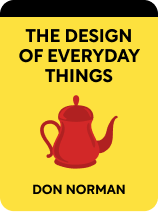

This article is an excerpt from the Shortform book guide to "The Design of Everyday Things" by Don Norman. Shortform has the world's best summaries and analyses of books you should be reading.
Like this article? Sign up for a free trial here .
Are you looking for design thinking exercises? How can these exercises help you practice design thinking?
These design thinking exercises can help you practice the concepts involved in design. You can use these exercises for specific design ideas, or to improve your skills overall.
Read more about design thinking exercises and how they work.
Top Design Thinking Exercises
These design thinking exercises use all aspects of design thinking to help you consider how design thinking work, and how you can do it.
Reexamine Everyday Objects
This first group of design thinking exercises helps you reexamine everyday objects and evaluate how they might work. We typically don’t think about the design of things around us unless they present a problem. This exercise will help you think critically about items you use every day.
This chapter looks at how the design of common items like doors, chairs, and kitchen appliances can influence how we interact with them. Take a moment to look around your environment right now. Choose one object within arm’s reach. Imagine showing the object to a friend who had never seen anything like it before. Do you think they would be able to figure out what it does? Would they be able to use it correctly?
What signifiers or perceivable affordances does the object have that would help your friend figure out its purpose? (Remember: Signifiers are signals that tell us where or how to interact with something, such as a “push” sign on a door. Perceivable affordances are obvious ways we can interact with an object, like a flat surface for supporting weight, or a hollow vessel for holding liquid.)
If you were to redesign this object to make it easier to use and understand, what changes would you make? (For example, adding signifiers, or rearranging controls to naturally map onto the object.) How would these changes help?
Now that you’re thinking like a designer, look around the room again. What other obvious signifiers do you see on other objects or appliances?
Break Down an Ordinary Action
The seven stages of action happen automatically for easy, routine tasks, but thinking through them consciously is a helpful tool for evaluating design. Let’s practice this now.
Assume that your goal for today was to sit down and read this summary (congratulations, you’ve already succeeded!). The next stages are plan and specify, which help us bridge the gulf of execution. (Remember, the plan stage is where we consider all possible options, and the specify stage is where we select one of those options to try.) List three ways you could have accomplished the goal of reading this summary. Which one did you act on?
Since you’re reading this, we know you met your goal—the gulf of evaluation has been bridged. Now let’s apply this process to a task you haven’t completed yet. Think of a small goal you’d like to accomplish by the end of today. This could be as simple as making lunch, or slightly more involved, like finishing a small work project. What is your goal?
List three different possible ways you could accomplish your small goal. Which of these options will you choose?
Once you act on your plan, you’ll need to bridge a new gap: the gulf of evaluation. How will you know when you’ve achieved your goal? (For example, if your goal was to eat lunch, the feeling of no longer being hungry might be a way to measure success.)
How did it feel to break down a simple task into such tiny steps? Were any of the steps more difficult to identify than others?
Do a Root Cause Analysis
Trace a small behavior backwards to find the big picture goal.
Imagine you’re in a library. You overhear someone ask the librarian where to find the science section. What is their immediate goal? What bigger goals might be driving that immediate goal? (Remember, the easiest way to determine this is to keep asking “why?” about each goal!)
Without more information, determining the root cause of a behavior can be subjective. Try this process again, imagining the same library scenario, but with a different chain of goals driving the behavior of asking for the science section.
Did thinking through a root cause analysis in the above questions come naturally to you? Is this tool something you use in everyday life? In what areas of your life would this tool be useful?
These design thinking exercises can help you identify and understand user behavior.
Redesign Reminders
This chapter covers a lot of information, and it can be difficult to connect it to concrete situations in our daily lives. This exercise asks you to redesign an element of your daily life using your new understanding of memory.
Think of a time recently when you created a reminder to help you remember a task or appointment. This could be any type of reminder—an alert in a phone app, a note placed somewhere prominent, a loved one you asked to help you remember, or even a mental association between two situations. What did you need to remember, and what type of reminder did you use?
In your reminder, what was the signal? What was the message? (Remember, the signal is your cue to remember something, and the message is what should be remembered.)
Did your reminder rely more on knowledge in the head or knowledge in the world? Did this work well for you?
If you were asked to remember the same type of information in the future, would you choose this type of reminder again? Why or why not?
Identify Physical Constraints
Physical constraints are so common in daily life that they can become invisible. This exercise will help you practice identifying physical constraints in everyday items.
Take a look at the physical device you’re using to read this summary (like a tablet, phone, or computer). Are there any parts that act as physical constraints? (Remember, physical constraints limit the ways you can physically interact with an object.)
If you found multiple physical constraints, choose just one to focus on for now. Why do you think the designer chose to incorporate this specific constraint? What actions do you think they were trying to prevent?
Do you think the designer was successful? Did they effectively prevent the unwanted action?
Ultimately, does this physical constraint make the device easier to use? If you were asked to edit this constraint to make it easier to understand and use, what changes would you make?
Identify System Errors
This chapter discussed the ways that systems are often designed without human needs in mind. Let’s connect this to your own experience.
If you experienced this error personally, did you blame yourself at the time? If you haven’t experienced this error, do you think you would blame yourself if it happened in the future?
Now, think about the error in light of what you learned in this chapter. Is there an underlying cause? (Remember, this could be the design of a physical object, but also company culture, work schedules, digital programs, and so on.)
Let’s use the idea behind “the five whys” to push this thinking even further. Keep asking yourself “why” until you get back to a fundamental issue underlying all the others. How many “whys” did it take to find the source?
Observe the Right Users in the Right Settings
We know that observation is the first step of the design thinking process, but choosing the right users and settings can be difficult. Let’s practice this now with these design thinking exercises.
Imagine you were asked to design a new type of computer keyboard. What types of people would you choose to observe? How would you choose?
What settings would you observe these people in?
If you had the chance to carry out these observations in the settings you chose, what specific things would you observe? What might be important for helping you identify problems with the current keyboard design? (For example, whether people have added wrist rests or other supports to their keyboard setups.)
Does Technology Make Us Smart?
The debate over whether technology makes us more or less intelligent rages on. This exercise will help you examine how technology affects your own life.
The author argues that technology makes us smart because it takes over menial jobs, giving us time and energy to devote to more involved tasks. Can you think of an example in your own life where technology has saved you time and allowed you to focus on other work?
Are there any parts of your daily routine that you could automate with technology but haven’t? What might be the pros and cons of automating that task?
Many people believe that technology makes us less intelligent, since it provides constant distraction and prevents us from learning to do things for ourselves. Has technology had this kind of effect in your own life, either in general or with particular devices and experiences?
Is there a middle ground here? Is technology helpful for you in some areas and harmful in others? Why do you think that is?
Consider Consumer Values
Think about the power you have as a consumer to influence design.
A product design is only successful if it attracts buyers. When you shop for durable goods like clothing or computers, what matters most to you? (For example: features, price, packaging, and so on.)
Do company values influence how likely you are to buy their products? What values do you look for in an ideal company to support? (For example: fair wages, sustainability, transparency, and so on.)
How important are those values to you when deciding whether to purchase something? Do they outweigh any of the other considerations you listed above (like price or features)?
Companies respond to consumer demands. Assuming it were financially possible, would you consider only supporting companies that align with your values? Why or why not?
Reflect on The Design of Everyday Things
Now that you’ve finished the summary, let’s figure out how to apply the lessons of the book to your own life.
This book covers a wide range of topics in both design and cognitive psychology. What information surprised you most? What are you still curious about?
In previous exercises, you practiced looking at everyday objects with a designer’s eye by identifying affordances, signifiers, constraints, mapping strategies, and mental models. Is there anywhere in your daily life where this new way of looking at objects could be helpful?
Did the lessons in this book change the way you think about errors? Is it helpful to think about tracing “human” errors in your own life back to design?
Going forward, what are your most important takeaways from this summary? How will you apply them to your own life?

———End of Preview———
Like what you just read? Read the rest of the world's best book summary and analysis of Don Norman's "The Design of Everyday Things" at Shortform .
Here's what you'll find in our full The Design of Everyday Things summary :
- How psychology plays a part in the design of objects you encounter daily
- Why pushing a door that was meant to be pulled isn't your fault
- How bad design leads to more human errors






